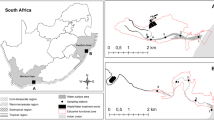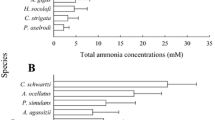Abstract.
Freshwater macroinvertebrate communities were established within 12 artificial streams or “toroidal” mesocosms and exposed to three replicated concentrations of ammonia for 29 days at constant temperature (16°C) and pH (median 8.4). The criterion units (CU = measured [ammonia]/US EPA 1985 chronic criterion value) of total ammonia in the LOW, MED, and HIGH treatments were 2.0, 4.8, and 13 CUs respectively, and 1.9, 5.8, and 12 CUs for the unionized ammonia. Macroinvertebrates were tolerant of the ammonia exposures with no significant (p > 0.1) effect on taxa richness; number of taxa in the orders Ephemeroptera, Plecoptera, and Trichoptera (EPT); or the quantitative macroinvertebrate community index (QMCI), a biotic index proposed for assessing effects of organic enrichment in New Zealand streams. Significant differences (p < 0.05) occurred for the mean abundance and the numbers of EPT individuals (QEPT), with the HIGH treatment significantly lower (−41%) than the control for both abundance and QEPT. Of the major species, only the mayflies Deleatidium sp. (Ephemeroptera: Leptophlebiidae) and Coloburiscus humeralis (Ephemeroptera: Oligoneuriidae) showed significant reductions in abundance, with only the caddisflies Beraeoptera roria (Trichoptera: Conoesucidae) and Confluens sp. (Trichoptera: Conoesucidae) showing significant increases in abundance. The abundance of juvenile Deleatidium sp. had a negative concentration-response relationship that resulted in an 82% decrease in abundance in the HIGH treatment. Drift of invertebrates showed no response to ammonia treatments. The 29-day EC50 values for Deleatidium sp. for total and unionized ammonia were 2.15 mg (N)/L (pH 8.4) and 0.145 mg (NH3-N)/L. No observed effect concentration (NOEC) values were 0.95 mg (N)/L and 0.066 mg (NH3-N)/L, and the threshold effect concentration (TEC) was 1.49 mg (N)/L and 0.102 mg (NH3-N)/L. Comparison of the Deleatidium sp. chronic ammonia sensitivity data with the US EPA 1985 chronic criterion value (CCC = 0.45 mg [N]/L, pH 8.4, 16°C) showed the TEC value for total ammonia was 3.3× CCC, and 2.2× higher than the updated US EPA 1998 criteria. The findings suggest that use of the US EPA criteria would provide minimal protection for Deleatidium for chronic ammonia exposure, and that development of site-specific criteria, covering a wide range of environmental conditions, may be required to adequately protect this species.
Similar content being viewed by others
Author information
Authors and Affiliations
Additional information
Received: 14 September 1998/Accepted: 24 April 1999
Rights and permissions
About this article
Cite this article
Hickey, C., Golding, L., Martin, M. et al. Chronic Toxicity of Ammonia to New Zealand Freshwater Invertebrates: A Mesocosm Study. Arch. Environ. Contam. Toxicol. 37, 338–351 (1999). https://doi.org/10.1007/s002449900523
Issue Date:
DOI: https://doi.org/10.1007/s002449900523




